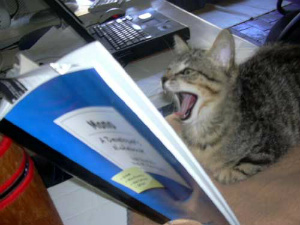National Novel Writing Month Is Over. Now It’s Time to Edit!
Biff Barnes
It’s the end of National Novel Writing Month. You have a finished (or even almost finished) draft in hand (or on your hard drive). Congratulations! Celebrate your accomplishment. Relax for a couple of days, then take the next step in getting your book ready for publication.
 Courtesy of Danny Ayers under Creative CommonsIf you’re like most of the people who met the NaNoWriMo challenge you’ve produced what Anne Lamott, in her book on writing Bird By Bird, calls a “shitty first draft.” How do you get from here to a version you want to send off to a printer or a literary agent?
Courtesy of Danny Ayers under Creative CommonsIf you’re like most of the people who met the NaNoWriMo challenge you’ve produced what Anne Lamott, in her book on writing Bird By Bird, calls a “shitty first draft.” How do you get from here to a version you want to send off to a printer or a literary agent?
Think about revision as a three step process:
1. You begin by producing the first draft. That’s done. Check. You need feedback to help you see what works well and what is not so effective in that initial effort. Getting it is often tricky. Most of us seek that initial feedback from people close to us, family, friends, and co-workers. Often these initial readers don’t provide much useful criticism. They like you. They don’t want to hurt your feelings. They say you things like, “It was good,” or “Great story,” or “I really liked it.” You can’t do much to improve your manuscript based on that.
Best-selling author Guy Kawasaki in his book APE: How to Publish a Book explains what he wants from those initial readers: "I send the first complete draft of my manuscripts to an inner sanctum of five to ten people. I’ve known them for years and trust their judgment. I want them to act like “book murderers,” a term Michael Alvear coined in his book Make a Killing on Kindle."
That kind of criticism may not come naturally to that first group of people you ask for feedback. You have to help them out. You need to tell your readers what you want to know. It’s best to give them specific questions you would like answered. Here are a few examples:
- Check for completeness. Ask: What are three questions you wish had been answered in the book?
- Check for clarity. Ask: Where in the book did you find things that were unclear or difficult to understand? What made them difficult?
- Check for understanding of the book’s ideas or theme. Ask: What was the book’s main idea? What parts of the book helped you see it most clearly?
- Check for cohesiveness. Ask: If you could cut one thing out of the book what would it be? Why?
- Check for the effectiveness of your storytelling. Ask: What was your favorite scene and why? Which scene did you like better, X or Y? Why?
sing questions like these your readers will know what to look for and be able to give you specific answers. You can look at their responses and know what may need work as you revise your draft.
2. Armed with what you learned from the first round of feedback you can produce a second draft which addresses the need for significant revisions or structural changes like eliminating flaws in the plot, sharpening characters or clarifying key ideas.
Then it’s time to repeat the process of seeking feedback. For this round of the cycle, seek out fellow writers. If you belong to a writing group you can draw upon fellow members for the feedback you need. If you don’t have such a group as an option, look for one in your area or online. There are also several sites such as Critters Workshop, Writers Cafe, or Critique Circle where you can get a good critique of the revised draft. Some people crowdsource their search for readers of their second draft by posting a request on Facebook, Google+ or Twitter asking for people to read the it.
3. Using the insights you have gained produce a polished third draft.
Some writers seek help from a professional editor early on in the process. A developmental edit of a first draft can save you a lot of time by identifying critical areas for revision.
You may even want to do have some people look at the final version before you send it to an agent or printer. Australian writer Alistair McGuinness, in a guest post on The Creative Penn, explained how he used audience surveys before publishing his novel Round the Bend. It’s an idea worth considering.
Give the book you produced this November the editing and revision it deserves to make it the best it can be. Good luck!
Share a tip on gathering feedback on your work, revision or editing below.